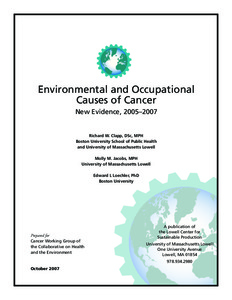Environmental and occupational causes of cancer: new evidence, 2005-2007
"This report chronicles the most recent epidemiological evidence linking occupational and environmental exposures with cancer. Peer-reviewed scientific studies published from January 2005-June 2007 were reviewed, supplementing our state-of-the-evidence report published in September 2005. Despit...
| Main Authors: | , , |
|---|---|
| Institution: | ETUI-European Trade Union Institute |
| Format: | TEXT |
| Language: | English |
| Published: |
Lowell, MA
2007
Lowell Center for Sustainable Production |
| Subjects: | |
| Online Access: | https://www.labourline.org/KENTIKA-19291847124910190299-environmental-and-occupational.htm |
| Summary: | "This report chronicles the most recent epidemiological evidence linking occupational and environmental exposures with cancer. Peer-reviewed scientific studies published from January 2005-June 2007 were reviewed, supplementing our state-of-the-evidence report published in September 2005. Despite weaknesses in some individual studies, we consider the evidence linking the increased risk of several types of cancer with specific exposures somewhat strengthened by recent publications, among them:
- brain cancer from exposure to nonionizing radiation, particularly radiofrequency fields emitted by mobile telephones;
- breast cancer from exposure to the pesticide dichloro-diphenyltrichloroethane (DDT) prior to puberty;
- leukemia from exposure to 1,3-butadiene; lung cancer from exposure to air pollution;
- non-Hodgkin's lymphoma (NHL) from exposure to pesticides and solvents; and
- prostate cancer from exposure to pesticides, polyaromatic hydrocarbons (PAHs), and metal working fluids or mineral oils.
In addition to NHL and prostate cancer, early findings from the Agricultural Health Study uggest that several additional cancers may be linked to a variety of pesticides. Our report also briefly describes the toxicological evidence related to the carcinogenic effect of specific chemicals and mechanisms that are difficult to study in humans, namely exposures to bis-phenol A and epigenetic, trans-generational effects. To underscore the multi-factorial, multi-stage nature of cancer, we also present a technical description of cancer causation summarizing current knowledge in molecular biology." |
|---|---|
| Physical Description: | 41 p. Digital |

